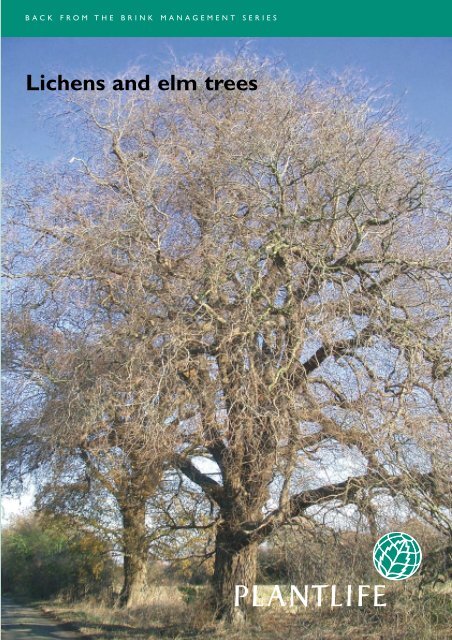Lichens and elm trees - Plantlife
Lichens and elm trees - Plantlife
Lichens and elm trees - Plantlife
- No tags were found...
You also want an ePaper? Increase the reach of your titles
YUMPU automatically turns print PDFs into web optimized ePapers that Google loves.
BACK FROM THE BRINK MANAGEMENT SERIES<strong>Lichens</strong> <strong>and</strong> <strong>elm</strong> <strong>trees</strong>
Back from the Brink Management SeriesElm <strong>trees</strong> were once a familiar part of the countryside <strong>and</strong> cultural l<strong>and</strong>scapethroughout the British Isles, with well grown <strong>trees</strong> often found in parkl<strong>and</strong>s, pastures<strong>and</strong> along roadsides. In some parts of the country Wych Elm was also a major component ofour ancient woodl<strong>and</strong>s.The main epidemic of Dutch Elm disease in the late 1960s <strong>and</strong> 1970skilled an estimated 20 million <strong>trees</strong>.This dramatically changed the l<strong>and</strong>scape of the British Isles,but the effect on the flora associated with these <strong>trees</strong> has been less widely documented.Why were Elm <strong>trees</strong> important for lichen?Over 200 lichen species have been recorded growing on <strong>elm</strong>s in Britain. Old Elm <strong>trees</strong> had arough, water retentive, naturally alkaline bark (pH 4 – 7), which lichens favour. Old <strong>elm</strong>s oftengrew in well-lit situations in open parkl<strong>and</strong>, in pasture <strong>and</strong> along roadsides which were ideal forthe colourful <strong>and</strong> species-rich Xanthorion lichen community to develop.This community ischaracterised by the presence of the bright yellow, leafy lichen Xanthoria parietina, along with grey<strong>and</strong> brown species belonging to the Physcia family. In many areas of central, eastern <strong>and</strong> southernEngl<strong>and</strong> these species were joined by a number of ‘Elm specialists’ including:● Anaptychia ciliaris Eagle’s claws● Bacidia incompta Sap-groove lichen● Caloplaca luteoalba Orange-fruited Elm-lichen● Collema fragrans Clustered mini-jelly lichen● Cryptolechia carneolutea Shy cross-your-heart lichen● Gyalecta flotowii Pale crater lichenToday, all these species are ‘Red Listed’, i.e. they have undergone a dramatic <strong>and</strong> significant decline,<strong>and</strong> are now rare <strong>and</strong> threatened not just in the British Isles but also in parts of Europe. Bacidiaincompta <strong>and</strong> Caloplaca luteoalba are also Priority Species under the UK Biodiversity Action Plan.Sap-groove lichen(Bacidia incompta)
Collema fragransAnaptychia ciliarisCaloplaca luteoalbaBacidia incomptaGyalecta flotowiiCryptolechia carneolutea
Back from the Brink Management SeriesThe decline of Orange-fruited Elm-lichen (Caloplaca luteoalba)Orange-fruited Elm-lichen was once widespread in central <strong>and</strong> south-eastern Engl<strong>and</strong> <strong>and</strong> partsof eastern Scotl<strong>and</strong> <strong>and</strong> unlike many lichens, it is relatively rare in the western oceanic areas. Itis a characteristic species of old Elm <strong>trees</strong> in parkl<strong>and</strong>s, pastures <strong>and</strong> along roadsides,sometimes found with other Elm specialists like Bacidia incompta <strong>and</strong> Collema fragrans, oftenassociated with wounds from cut branches. By the start of the Dutch <strong>elm</strong> disease epidemic ithad already declined through the loss of hedgerows <strong>and</strong> atmospheric pollution due to sulphurdioxide, but between 1960 <strong>and</strong> 1980 it under went a dramatic decline.All recordsCurrent sitesCurrent information indicates this species is no longer found on Elm in Wales <strong>and</strong> has beenrecorded from only three <strong>trees</strong> since 2000 in Engl<strong>and</strong>. In Scotl<strong>and</strong> the species is doing ratherbetter although Dutch <strong>elm</strong> disease is progressing up the east side, threatening surviving Elms<strong>and</strong> their associated lichens.
Back from the Brink Management SeriesThe importance of wayside <strong>trees</strong>Isolated <strong>trees</strong> along roadsides, by tracks <strong>and</strong> in pastures are collectively known as wayside <strong>trees</strong>.Their well-lit trunks may be affected by nutrient enrichment from dung <strong>and</strong> dust particles, so thelichen species found on these <strong>trees</strong> are very different from those found in ancient woodl<strong>and</strong>.In the absence of Elms, <strong>trees</strong> with a naturally alkaline bark (such as Ash, Maple <strong>and</strong> Sycamore)are very important for many lichens including some that were formerly widespread on the oldElms. Several of the former ‘Elm specialists’ often favour damaged <strong>trees</strong>, occurring around <strong>and</strong>below old wounds <strong>and</strong> sap runs, or are found on hard lignum inside hollow <strong>trees</strong>.How can we conserve these species?All the Elm lichen specialists survive, albeit in small quantities, on other <strong>trees</strong> such as Ash, Beech,Field Maple, Horse Chestnut <strong>and</strong> Sycamore.They show a preference for veteran <strong>trees</strong> that areoften hollow or wounded, <strong>and</strong> are sometimes found on <strong>trees</strong> that receive no statutory protection.Conserving <strong>and</strong> managing these veteran wayside <strong>trees</strong> will help to protect these <strong>and</strong> many otheruncommon <strong>and</strong> declining lichen species. Current threats to wayside tree lichens include the:●●●●Continuing loss of old wayside <strong>trees</strong> through natural causes <strong>and</strong> theirnon-replacementLoss of <strong>trees</strong> along roadsides due to road improvement schemesIncrease of ammonia <strong>and</strong> nitrogen pollution occurring as a result ofintensive agricultureIncrease of Ivy on the trunks of hedgerow <strong>trees</strong> smothering the lichens thatgrow on themElm specialists <strong>and</strong> many other lichens associated with wayside tree habitats can be conserved by:●●●●Protecting <strong>trees</strong> supporting populations of Elm specialists through TreePreservation OrdersLiaising with l<strong>and</strong>owners <strong>and</strong> managers of sites with important populations ofElm specialists <strong>and</strong> other threatened wayside tree speciesEnsuring good practice is used when managing habitats around <strong>and</strong> adjacent toimportant <strong>trees</strong>Developing agri-environment schemes to encourage tree planting in placesthat have been highlighted as important for lichens that grow on wayside <strong>trees</strong>
Further advice <strong>and</strong> information on lichens associated with Elm <strong>trees</strong>can be obtained from:<strong>Plantlife</strong> InternationalThe Conservation Officer14 Rollestone Street, British Lichen SocietySalisbury,The Natural History MuseumWiltshireCromwell Road,SP1 1DXLondonTel: 01722 342730SW7 5BDEmail: enquiries@plantlife.org.ukEmail: b.edwards@dorset-cc.gov.ukEnglish NatureNorthminster House,Northminster,Peterborough,PE1 1UATel: 01733 455000Orange-fruited Elm-lichen (Caloplaca luteoalba)BRITISH LICHENSOCIETYText written by Bryan EdwardsPhotographs by Bryan Edwards & The Natural History Museum<strong>Plantlife</strong> International wishes to acknowledge the financial support of English Nature in this jointlyresourced project.See also: Veteran Trees: A guide to good management. Helen Read. English Nature. 2000.Elm map project: http://www.ramblers.org.uk/<strong>elm</strong>s/default.htmISBN: 1 904749-06-2DESIGN: RJP DESIGN 01234 315147
















